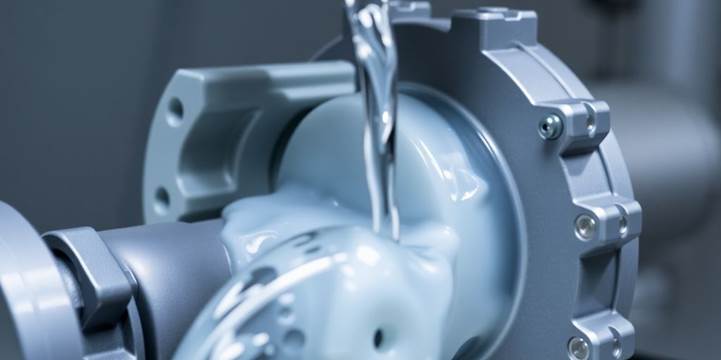Definition and Functionality
A diaphragm pump, also known as a membrane pump, is a type of positive displacement pump. It uses a flexible diaphragm to create pressure and move fluids. These pumps are known for their ability to handle a wide range of fluids, from water to corrosive chemicals.
Diaphragm pumps are used in many industries. They are great for fluid transfer and lower pressure spray applications that require a smooth and consistent flow.
They are often chosen for their ability to handle fluids with solids.
Types of Diaphragm Pumps
There are primarily two main types of diaphragm pumps: air-operated (AODD) and mechanically driven. AODD pumps use compressed air to move the diaphragm, while mechanically driven pumps use a motor and crankshaft. Each type has its own set of advantages and is suited for different applications.
Air-operated diaphragm pumps are often favored for their simplicity and ability to run dry without damage. Electric diaphragm pumps offer more precise control and energy efficiency.
Choosing the right type depends on factors like the fluid being pumped, flow rate, and pressure requirements.
Key Advantages of Diaphragm Pumps
Diaphragm pumps offer several key advantages. They can handle abrasive and corrosive fluids. They are also self-priming and can run dry without damage.
Another advantage is their ability to handle fluids with high viscosity or solid content. This makes them suitable for a wide range of applications.
Diaphragm pumps are versatile and reliable, making them a popular choice in many industries. Their design minimizes the risk of leaks and contamination, which is crucial in applications where purity is important.
How Diaphragm Pumps Operate

The Working Principle
Diaphragm pumps operate using reciprocating action. This creates a temporary chamber to move fluids. The pump uses flexible diaphragms. These diaphragms move back and forth.
This motion changes the volume inside the pump chamber. When the volume increases, fluid is drawn in. When the volume decreases, fluid is pushed out. It’s a simple but effective way to pump liquids.
The Role of Diaphragms
The diaphragms are the heart of the diaphragm pump. They act as a barrier between the air and the fluid. This prevents contamination.
They flex back and forth, creating suction and pressure. The material of the diaphragm is important. It needs to be compatible with the fluid being pumped.
Diaphragms provide a leak-free seal. This is important for handling hazardous or sensitive materials.
Fluid Movement Process
The process starts with one diaphragm moving, creating a vacuum. This vacuum pulls fluid into the pump chamber. Check valves ensure the fluid only moves in one direction.
Next, the diaphragm moves in the opposite direction. This decreases the volume of the chamber. The fluid is then forced out through another check valve.
The reciprocating motion of the diaphragms creates a continuous flow. This flow is consistent and reliable, making diaphragm pumps suitable for a variety of applications.
Here’s a quick breakdown:
- Suction stroke: Diaphragm moves, creating vacuum.
- Discharge stroke: Diaphragm moves back, pushing fluid out.
- Check valves: Ensure one-way flow.
Applications of Diaphragm Pumps
Industries Utilizing Diaphragm Pumps
Diaphragm pumps are workhorses across many sectors. They’re valued for their ability to handle diverse fluids. Think chemical processing, water treatment, and even food and beverage.
These pumps are also common in pharmaceuticals and the automotive industry. Their versatility makes them a go-to solution for fluid transfer needs.
Common Use Cases
Diaphragm pumps shine in specific applications. They excel at transferring corrosive chemicals and handling viscous materials. This is due to their design and material options.
They’re also great for metering and dosing applications. Plus, they can manage fluids with suspended solids, like slurries.
Diaphragm pumps are often selected when leak-free operation is critical, or when the fluid being pumped is hazardous or sensitive.
Benefits in Specific Applications
In wastewater treatment, diaphragm pumps handle sludge and chemicals effectively. In the food industry, they ensure hygienic transfer of ingredients.
Chemical plants rely on them for safe handling of acids and solvents. The automotive sector uses them for paint transfer and waste disposal.
Ultimately, the benefits stem from their reliability, material compatibility, and ability to prevent contamination.
Components of a Diaphragm Pump
Central Body and Pneumatic Exchanger
The central body is the heart of the diaphragm pump. It houses the air inlet and outlet. It also contains the pneumatic exchanger, which is super important for making the pump work.
The pneumatic exchanger directs compressed air. This alternating pressure moves the diaphragms. This movement creates the pumping action.
Think of the pneumatic exchanger as the conductor of an orchestra. It makes sure everything happens in sync.
Fluid Chambers
Fluid chambers are where the magic happens. These chambers are where the fluid is drawn in and pushed out. The diaphragms create a changing volume within these chambers.
As one diaphragm moves, it creates suction. This suction pulls fluid into the chamber. Then, the diaphragm reverses, pushing the fluid out.
It’s a simple but effective design. The fluid chambers are essential for the pump’s operation.
Valves and Diaphragm Materials
Valves control the flow of fluid. They ensure it moves in the right direction. Diaphragm materials are also critical.
Different materials handle different fluids. Some materials are better for corrosive chemicals. Others are better for high-temperature applications.
Choosing the right materials is key. It ensures the pump’s longevity and performance. The valves and diaphragm materials are the unsung heroes of the diaphragm pump.
Advantages of Using Diaphragm Pumps
Versatility in Fluid Handling
Diaphragm pumps really shine when it comes to handling different kinds of fluids. They can pump everything from water to corrosive chemicals. This makes them super useful in lots of industries.
They’re also good at dealing with fluids that have solids in them, like slurries. This is because of their design, which is pretty resistant to clogging.
Diaphragm pumps can handle a wide range of viscosities, from thin liquids to thick pastes. This adaptability makes them a solid choice for various applications.
Maintenance and Durability
Diaphragm pumps are known for being pretty low-maintenance. They don’t have a ton of moving parts, which means there’s less stuff to break down. This can save you time and money on repairs.
They’re also built to last. The diaphragms themselves are made from tough materials that can withstand a lot of wear and tear.
Because of their simple design and durable construction, diaphragm pumps often have a longer lifespan than other types of pumps. This makes them a cost-effective option in the long run.
Safety Features
Safety is a big deal, and diaphragm pumps have some nice features in that area. They can run dry without getting damaged, which is a plus if you accidentally run out of fluid.
They’re also good at preventing leaks. The diaphragm creates a seal that keeps the fluid contained. This is important when you’re dealing with hazardous materials.
Diaphragm pumps can be designed to meet specific safety standards, like those for explosive environments. This makes them a safe choice for a wide range of applications.
Challenges and Limitations of Diaphragm Pumps

Potential Issues with Viscosity
Diaphragm pumps can struggle with highly viscous fluids. Viscosity affects flow rate and efficiency. Thicker fluids require more power to move, reducing pump performance.
High viscosity can also cause increased wear and tear. The pump’s components work harder, shortening lifespan. Regular maintenance is key to mitigating these issues.
Consider alternative pump types for extremely viscous materials. Gear pumps or lobe pumps might be more suitable.
Limitations in Pressure Handling
Diaphragm pumps generally operate at lower pressures. This limits their use in high-pressure applications. Exceeding pressure limits can damage the diaphragms.
Pressure limitations also affect the distance fluids can be pumped. Longer distances require higher pressures to overcome friction.
Diaphragm pumps are not ideal for applications needing significant head pressure. Other pump designs are better suited for these tasks.
Cost Considerations
Initial cost can be higher compared to some other pump types. The complexity of the design contributes to this.
Maintenance costs can also add up over time. Diaphragm replacement is a recurring expense. The diaphragm material affects its lifespan.
Consider the total cost of ownership when choosing a pump. Factor in purchase price, maintenance, and potential downtime.
Future Trends in Diaphragm Pump Technology
Innovations in Design
Diaphragm pump design is evolving. Expect to see more compact, efficient models. New materials and manufacturing techniques are key.
- 3D-printed components for customization.
- Modular designs for easier maintenance.
- Smart sensors for real-time monitoring.
These changes aim to improve performance and reduce downtime.
Sustainability and Efficiency
Sustainability is a major focus. Diaphragm pumps are becoming more energy-efficient. This reduces their environmental impact.
- Optimized air consumption in AODD pumps.
- Use of recyclable materials.
- Reduced noise levels.
These improvements make diaphragm pumps a greener choice.
Market Growth and Demand
The diaphragm pump market is growing. Demand is driven by various industries. Expect increased adoption in emerging markets.
Diaphragm pumps are essential for handling difficult fluids. Their versatility ensures continued relevance.
This growth reflects the pumps’ reliability and adaptability.
Wrapping Up: Understanding Diaphragm Pumps
In summary, diaphragm pumps are pretty handy tools that play a big role in various industries. They work by using flexible diaphragms to create a pumping action, which makes them great for moving different types of fluids, even those that are tough or hazardous. Whether you’re in food production, chemical processing, or any other field that needs reliable fluid transfer, these pumps can get the job done. Plus, with their ability to handle a range of pressures and materials, they offer a lot of versatility. So, if you’re considering a pump for your next project, a diaphragm pump might just be the right choice.













